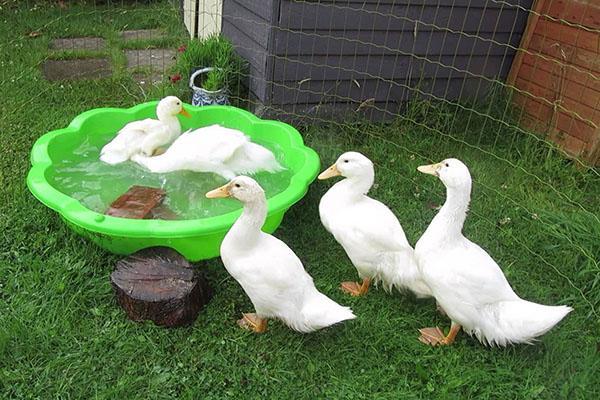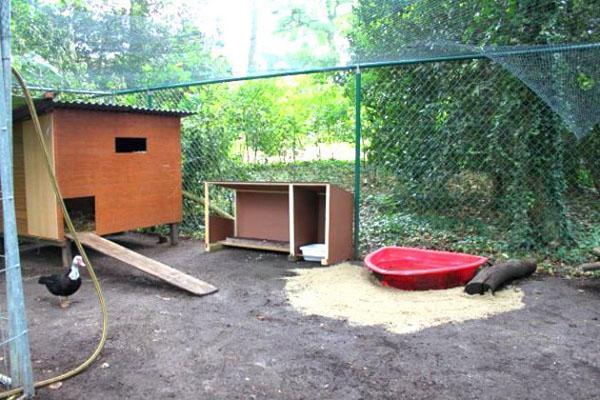How to properly keep and feed ducks at home
 Breeding ducks at home has many advantages, since from this bird you can get not only meat, but also eggs, fluff and dung as fertilizer. Almost all breeds gain weight quickly, and it is not necessary to constantly feed them with special compound feed. If the bird has free range in an open reservoir, then the consumption of purchased feed is reduced by 30-40%, since they themselves will be able to get their own food.
Breeding ducks at home has many advantages, since from this bird you can get not only meat, but also eggs, fluff and dung as fertilizer. Almost all breeds gain weight quickly, and it is not necessary to constantly feed them with special compound feed. If the bird has free range in an open reservoir, then the consumption of purchased feed is reduced by 30-40%, since they themselves will be able to get their own food.
Read also the article in the topic:Indoor women - breeding, maintenance, care at home!
Positive aspects and features of duck breeding
Duck meat has the following benefits:
- superior in quality to chicken;
- contains a huge amount of useful and easily digestible trace elements;
- there are breeds with low calorie dietary meat.

If ducks are kept only in a cage, then their productivity can be significantly reduced due to a sedentary lifestyle and obesity. Accordingly, the quality of the meat deteriorates.
Poultry house
 Before raising ducks, you need to build a house for them. A height of one and a half meters will be enough for. For construction, you can use almost any material. The main thing is that they are environmentally friendly and safe, such as wood. One of the main conditions for breeding ducks is that the room must be clean, dry and free of drafts. Although they are waterfowl, they cannot live in dampness and mud, especially since in such conditions there is a danger of an outbreak of infectious or viral diseases. The floor is made of wood or clay.
Before raising ducks, you need to build a house for them. A height of one and a half meters will be enough for. For construction, you can use almost any material. The main thing is that they are environmentally friendly and safe, such as wood. One of the main conditions for breeding ducks is that the room must be clean, dry and free of drafts. Although they are waterfowl, they cannot live in dampness and mud, especially since in such conditions there is a danger of an outbreak of infectious or viral diseases. The floor is made of wood or clay.
The humidity in the duck house should not be more than 65-70%, otherwise the feathers of the ducks begin to fall out, and immunity decreases.
The area of the house is calculated in such a way that for 1 m2 housed no more than three adults. Ducks do not need perches or other tall devices. Everything should be on the floor or practically near it.
The house floor should be at least 20 cm above the ground. This is necessary so that rodents cannot get inside, since they not only eat food, but are also carriers of dangerous diseases.
 On the floor in poultry house to keep ducks, be sure to lay a bed of straw, sawdust or hay. In winter, the layer is made thick, up to 40 cm thick, so that the bird can burrow into it and warm up. Change it as needed or once a week. In summer, the litter is either completely removed or made thin. In winter, house temperatures should be above 0 ° C. It is very important that the duck house has ventilation, such as a window, as hazardous gases are emitted from the droppings.
On the floor in poultry house to keep ducks, be sure to lay a bed of straw, sawdust or hay. In winter, the layer is made thick, up to 40 cm thick, so that the bird can burrow into it and warm up. Change it as needed or once a week. In summer, the litter is either completely removed or made thin. In winter, house temperatures should be above 0 ° C. It is very important that the duck house has ventilation, such as a window, as hazardous gases are emitted from the droppings.
In winter, when the bird is in the house most of the time, it should be light at least 12-14 hours a day.Otherwise, they stop rushing, and their activity is noticeably reduced.
In addition to ducks, you can keep other birds (chickens, geese, turkeys) in the poultry house, the main thing is to separate them with a partition at least 70 cm high, otherwise the males will fight each other.
Nest and feeders
 A nest for ducks at home is made from 30 to 50 cm high, 50 cm wide and deep.It is installed in a dark place. Since ducks have short legs, the threshold into it is made no more than 8 cm high. One nest is enough for two or three individuals.
A nest for ducks at home is made from 30 to 50 cm high, 50 cm wide and deep.It is installed in a dark place. Since ducks have short legs, the threshold into it is made no more than 8 cm high. One nest is enough for two or three individuals.
For dry food, feeders are built from wood, and for wet mash made of metal or plastic, to make it easier to clean them. Since ducks are sloppy birds and always scatter feed, there should be a rail or any other bar in the middle of the container that does not allow them to climb onto the feed from above.
To eat dry food, it is enough to allocate 6 cm per 1 individual, for wet mash 15 cm. The main thing is that each bird can freely come up and eat. If there is not enough space, then weak individuals will always stay away and eat less food, which will further slow down their development and growth.
Different compartments are made for mineral supplements. The drinking bowl should be of such a depth that the bird can completely dip its beak, for example, 20 cm. Ducks drink a lot of water, so you need to constantly monitor its availability and freshness.
Where and how to make an area for walking and swimming
 Domestic duck rearing will be less costly and easier if the bird can walk outside the cage. In addition, this will eliminate the likelihood of their obesity. It is imperative to take a place for swimming. You can do it yourself, but in such a way that it is possible to change the water and clean out the dirt. Even better, if the ducks have access to a natural reservoir, then they can feed on insects and grass. Bathing promotes rapid growth and development of birds.
Domestic duck rearing will be less costly and easier if the bird can walk outside the cage. In addition, this will eliminate the likelihood of their obesity. It is imperative to take a place for swimming. You can do it yourself, but in such a way that it is possible to change the water and clean out the dirt. Even better, if the ducks have access to a natural reservoir, then they can feed on insects and grass. Bathing promotes rapid growth and development of birds.
Naturally run ducks will be able to find and select the food they need, which has a positive effect on digestion and health.
To prevent the bird from swimming away, a fence is made in an open reservoir. It should be about 70 cm in the water, and 50 cm above the water. If you do not make it, then the bird, diving, will swim out of the enclosure. In addition, such a corral will protect the flock from predators. It is best to place the walking enclosure immediately at the entrance to the house on the south or southeast side of it. Fencing it with a net or picket fence with a height of at least 1 m.
 The area for raising ducks is calculated so that the whole bird can move freely, or with the expectation that 1-1.5 m is needed for 1 individual2... The manhole for exiting the duckhouse is made square with sides of 40 cm. The latch for it is installed outside.
The area for raising ducks is calculated so that the whole bird can move freely, or with the expectation that 1-1.5 m is needed for 1 individual2... The manhole for exiting the duckhouse is made square with sides of 40 cm. The latch for it is installed outside.
Do not keep too many bird heads in the house or cage, as this negatively affects their condition and health.
The video shows an example of how you can breed ducks at home in winter.
Feeding ducks
 In order for ducks to receive adequate nutrition and grow quickly, their diet should contain not only compound feed, but also fresh grass, mineral supplements and wet mash. Combined feed can be purchased ready-made or made by hand. This will require grain crops: barley, wheat, corn, as well as sunflower meal, fat, meat and bone or fish meal, salt, milk powder, premix and shells. You should not overfeed the bird, otherwise the meat will be too fat.
In order for ducks to receive adequate nutrition and grow quickly, their diet should contain not only compound feed, but also fresh grass, mineral supplements and wet mash. Combined feed can be purchased ready-made or made by hand. This will require grain crops: barley, wheat, corn, as well as sunflower meal, fat, meat and bone or fish meal, salt, milk powder, premix and shells. You should not overfeed the bird, otherwise the meat will be too fat.
Feed should be added as much as the ducks can eat at a time.
In winter and spring, when it is still too cold outside and there is no grass with insects, ducks are fed at home at least three times a day. Wet mash is given in the morning and afternoon, and in the evening combined feed... If the ducks can already feed on the walk, then it is enough to give out food 2 times a day, morning and evening.
 If a sluggish bird appears among the whole flock, then it should be immediately separated into another cage and the cause of the weakness should be identified.After that, it is necessary to thoroughly clean and disinfect the duckling to avoid the spread of the disease.
If a sluggish bird appears among the whole flock, then it should be immediately separated into another cage and the cause of the weakness should be identified.After that, it is necessary to thoroughly clean and disinfect the duckling to avoid the spread of the disease.